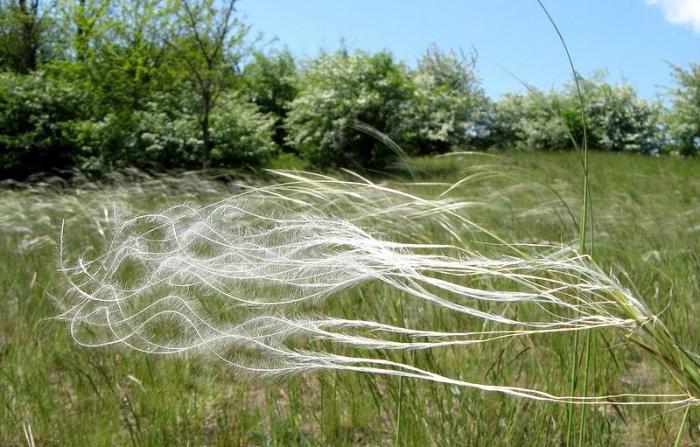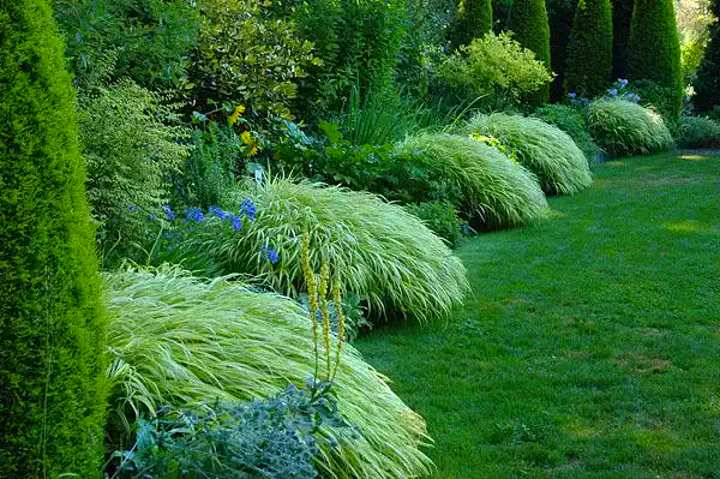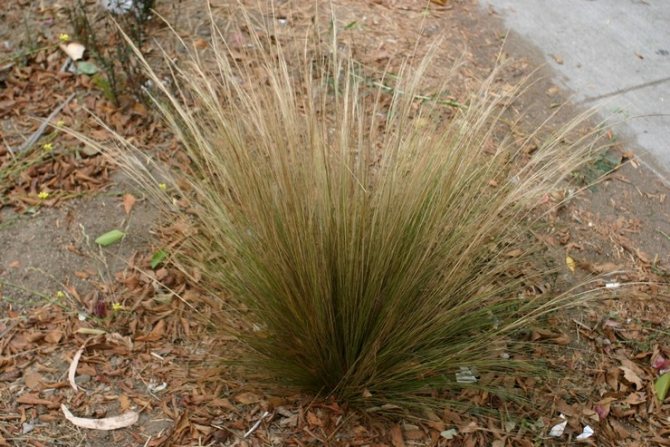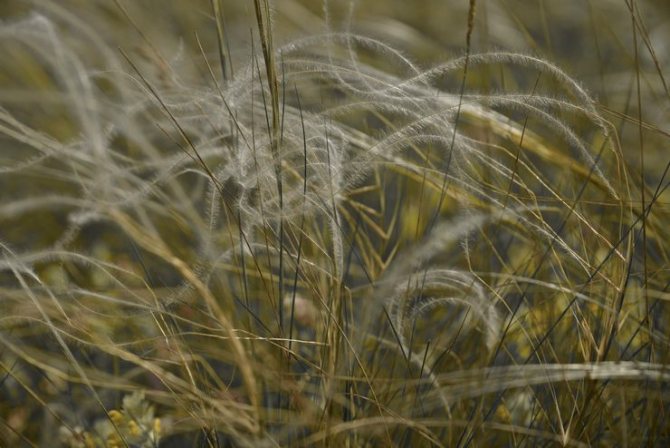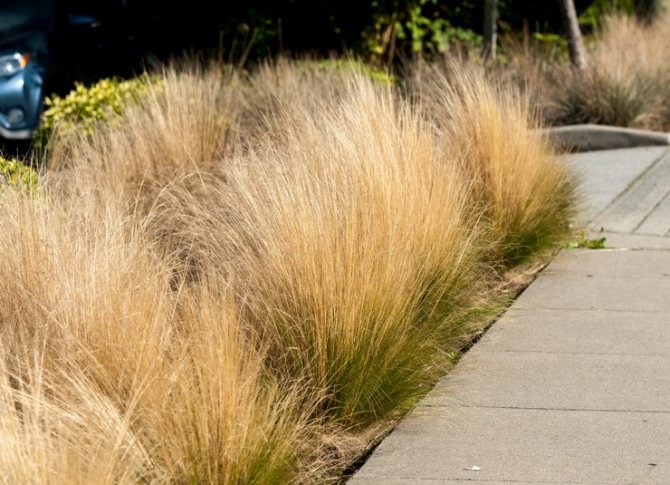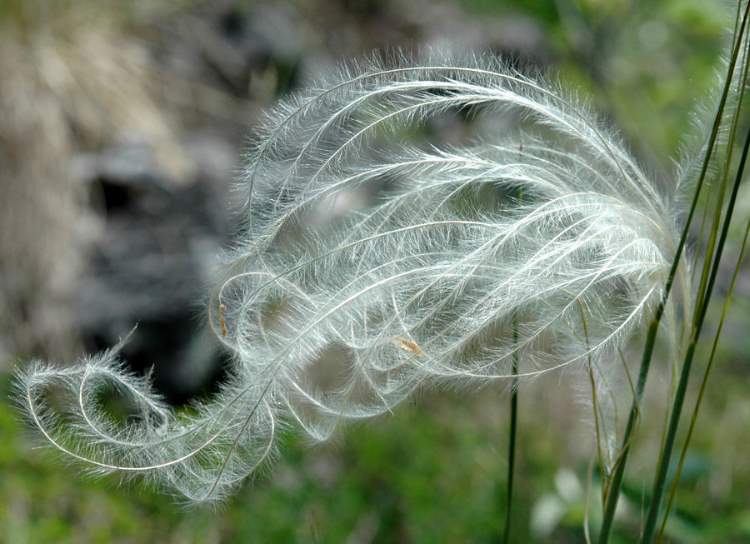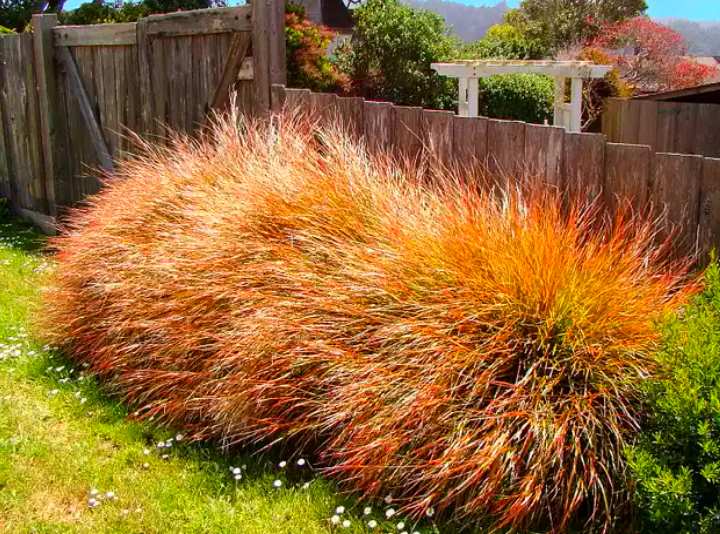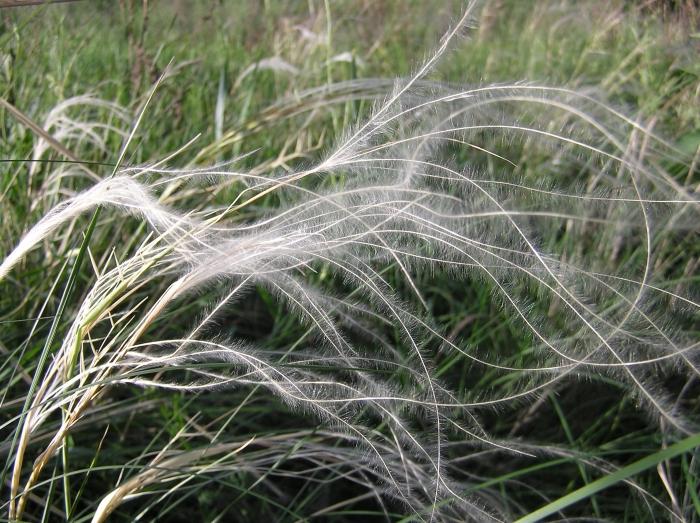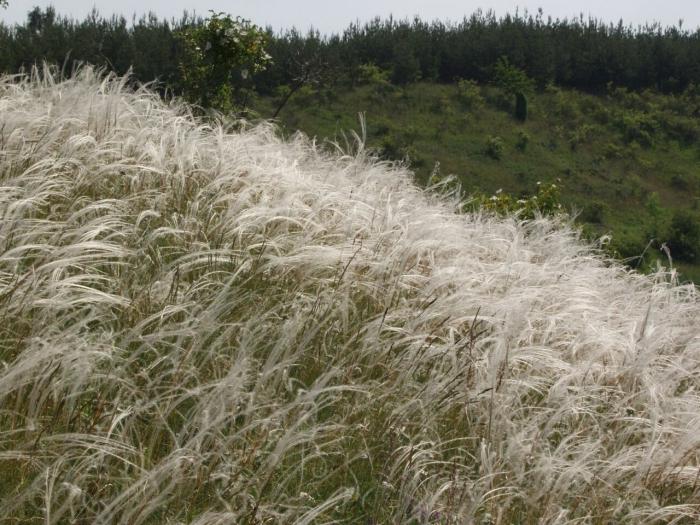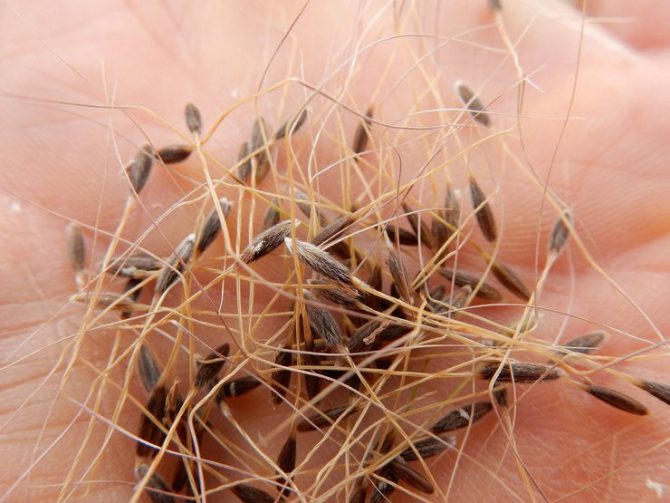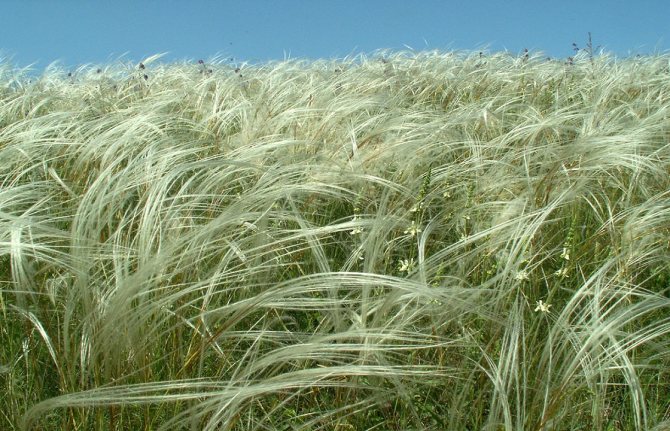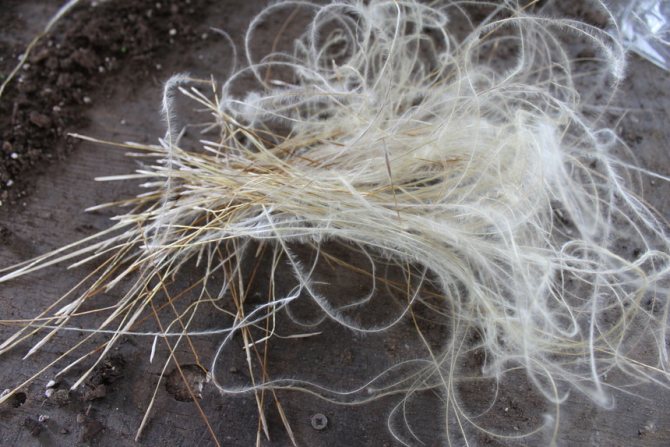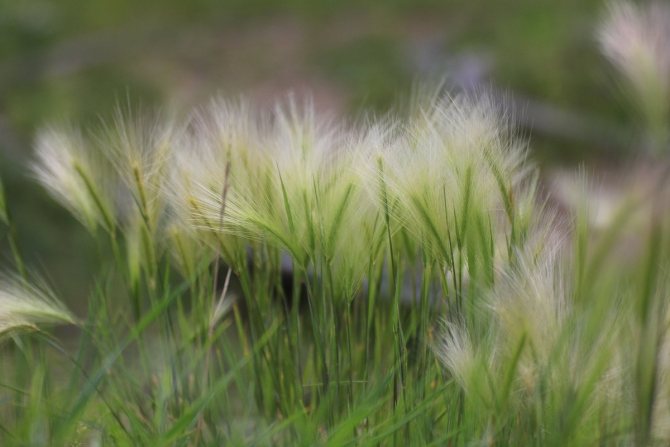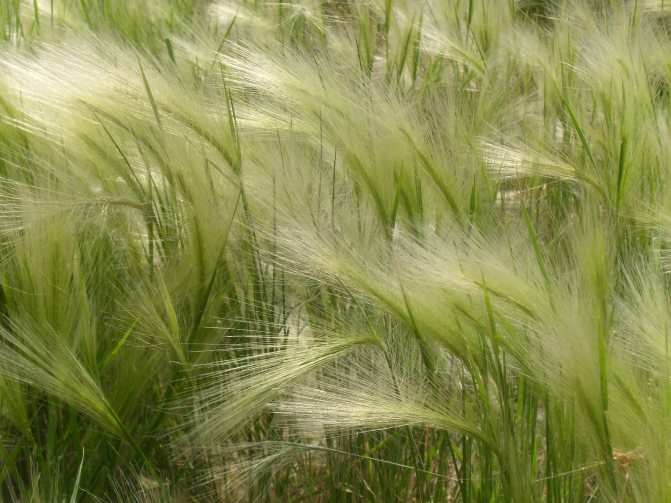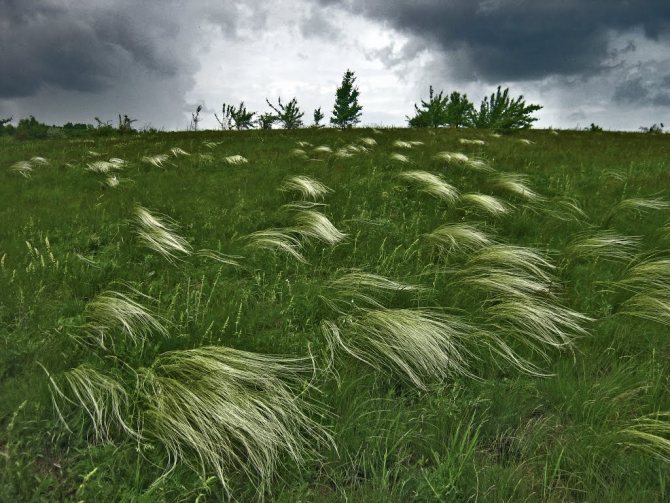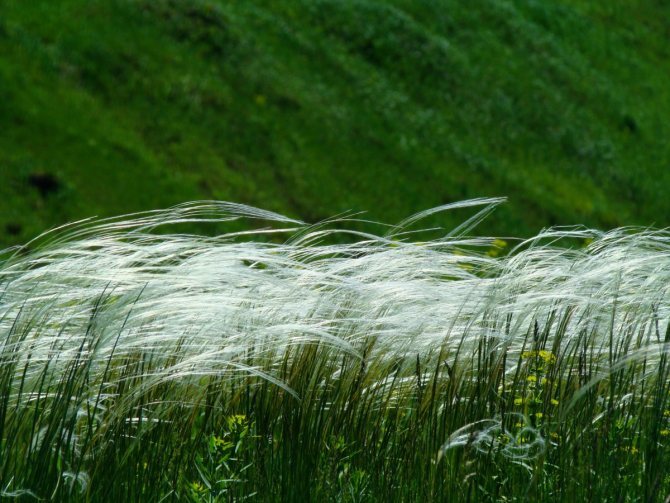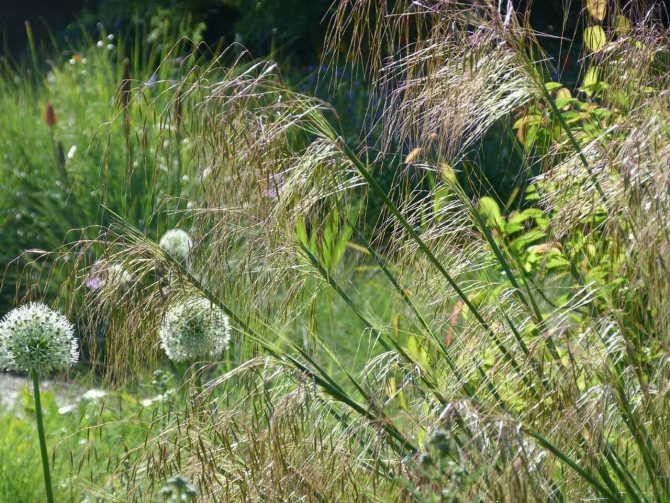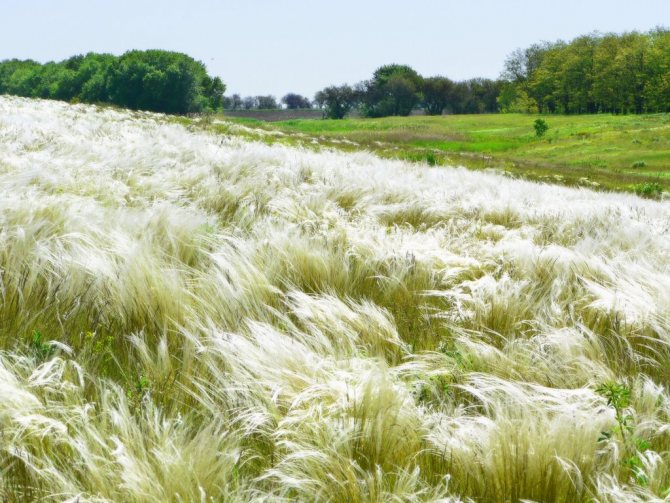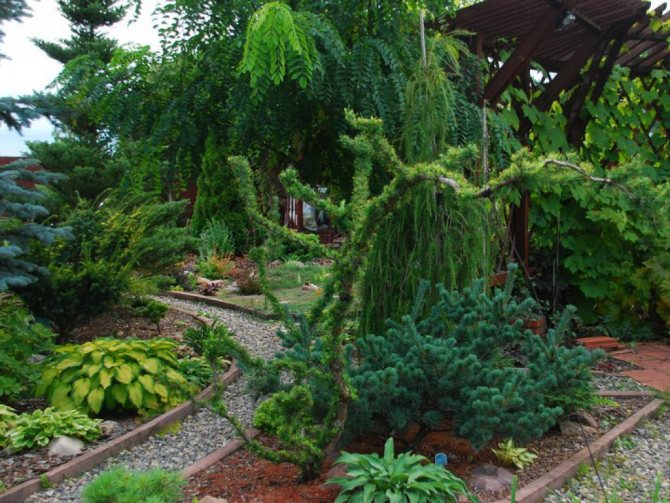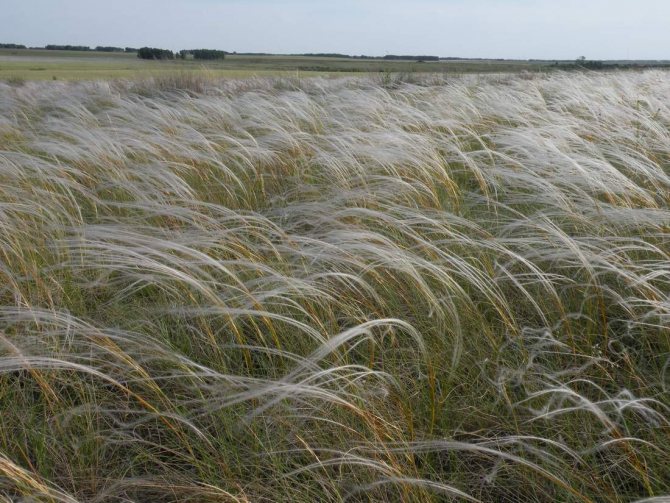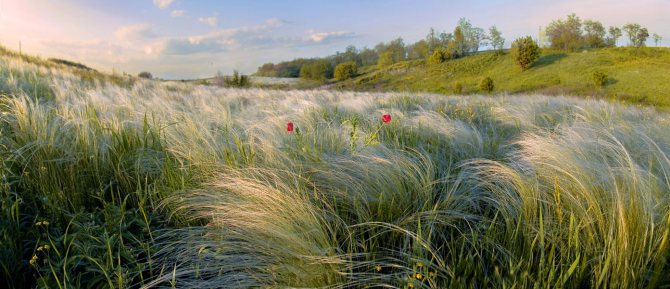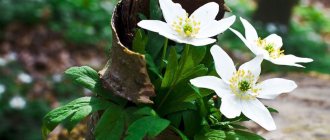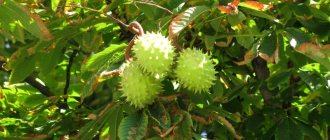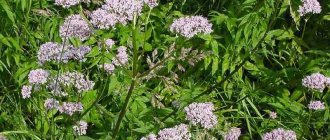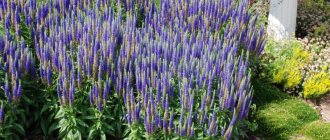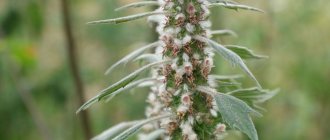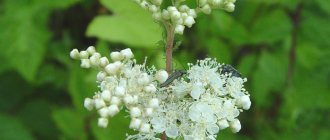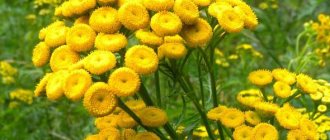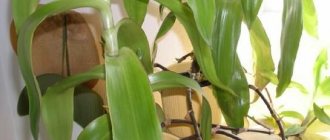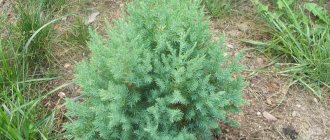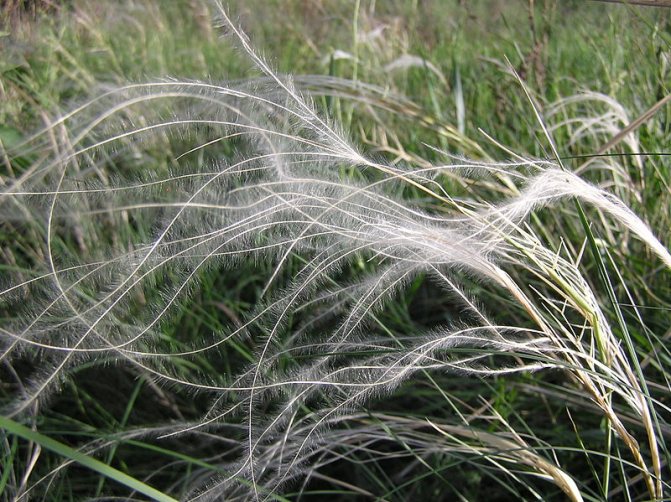
- September 24, 2018
- Wild plants
- Natalia Penchkovskaya
Feather grass is a perennial herb that is not found on black soil. She took a fancy to steppe, mountainous and semi-desert lands located in zones with a temperate climate. In different areas, this herb is called differently. You can find the following names: feather grass, boletus, hairs, marin flax, sheep's death, beloved, whistle, pernik, thyrsa, stepchina, silk grass.
There are quite a few varieties of feather grass plant, the photo of which is posted in the article. Some sources indicate 300 to 400 species. In appearance, they are very similar to each other. It is a tall herb with a short and non-creeping rhizome. The stems rise above the ground to a height of 30 to 80 cm. They resemble a dense turf with straight stems and stiff leaves that look like plates.
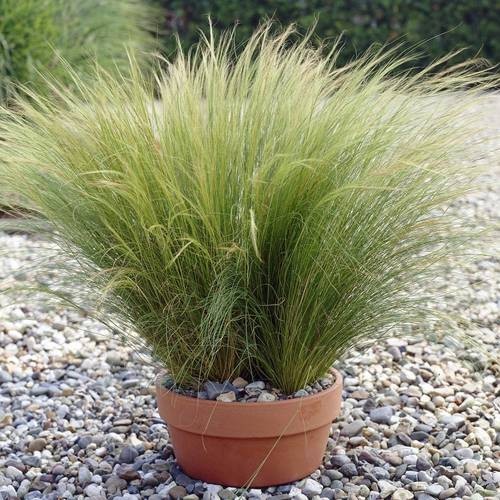

In the article, we will consider a description of the feather grass plant with a photo, where you can find such grass, where it is used, whether it is suitable for animal feed. We will also figure out how to grow this plant for landscape design, what are its features. Some medicinal properties of the herb are used for medicinal purposes, and for what diseases, you will learn from the article.
Description and characteristics of this steppe plant: in which zone does it grow?
Let's start with a short description of the flower. Feather grass, popularly called "sheep's death", "tyrsa" or "pernik", - is a perennial herb belonging to the Zlakov family, the Myatlikov subfamily.
It is difficult to confuse it with other plants. A short rhizome, a bunch of narrow, often twisted leaves and a silky panicle inflorescence are typical features of all types of feather grass.
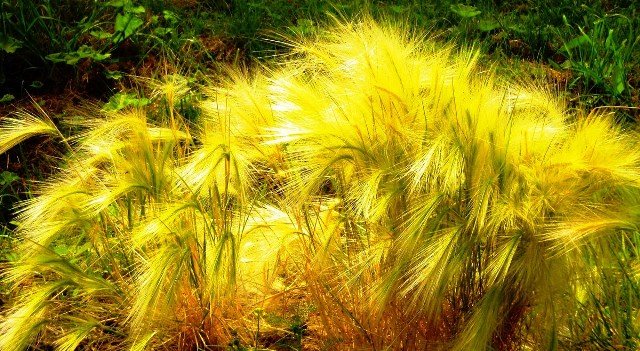

Feather grass
The root system of bluegrass is poorly developed. Therefore, feather grass cannot grow on the powerful perennial sod of fertile meadows. But if several dry years fall one after another on some territory, the sod layer is weakened. This means that soon it will be filled with feather grass. The same happens with pastures and hayfields, on which last year's grass is burned. This phenomenon is called steppe (stumbling) of the meadow.
In addition to meadows and steppes, feather grass can grow on any patch of soil: among stones, in rocks, on gentle hills scorched by the sun.
Description of the plant
This perennial herb looks impressive, so it is often used to decorate plots. Inflorescences are represented by panicles and lush spikelets, each having one flower with two covering scales. Rigid leaves look like a wire twisted at the base into a tube.
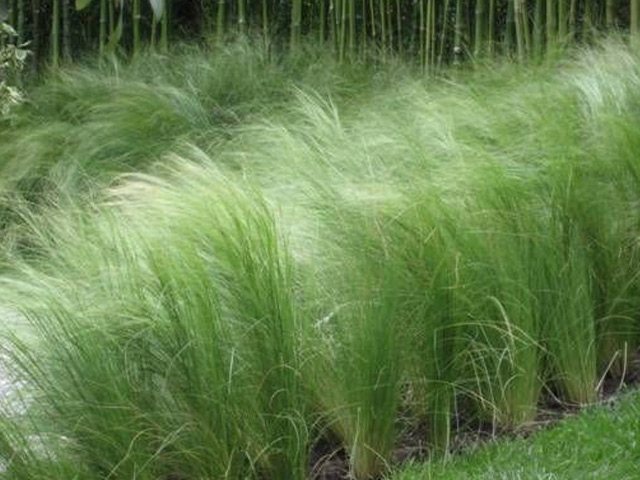

Spikelets tightly cover the grains until they ripen, and subsequently the awn falls off. The leaves of the feather grass plant are twisted into tubes, but flat varieties can often be found. During flowering, large spikelets are formed, collected in panicles of several pieces. This happens in May or early June. However, do not wait for flowering in the first or even in the second year after planting. The steppe feather grass begins to bloom intensively in the 3rd, less often - the 4th year after planting.
Types of grass feather grass in the steppe
Worldwide, there are more than three hundred species of this plant, of which about a third are herbs.
On the territory of the Russian Federation, there are such types of feather grass as:
- pinnate;
- beautiful;
- hairy;
- Far Eastern;
- pubescent;
- Zalessky.
The most common types of feather grass are hairy and feathery. They are found in the arid regions of Western Europe, in the steppes in southern Russia and even in Siberia. However, truly untouched islets of wild nature, where feather grass has been growing from time immemorial, are only two reserves - Khomutovskaya steppe (in Donetsk region) and Askania-Nova (in Kherson region).
Feed value
Feather grass, the photo of which you can see in the article, is also used as a forage crop. However, only some species of this plant are applicable to grazing livestock. Feather grass is harvested for such purposes before it blooms, when the stems are not yet coarse. To feed horses and sheep, feather grass is mixed with other grasses and only after that they are given to livestock for eating. This type of grass is not fed to cattle due to its low nutritional value compared to other perennial grasses of our steppes.
Beneficial features
Traditional medicine has long appreciated the beneficial properties of feather grass... It is used in the treatment of goiter, rheumatism, joint pain, multiple sclerosis, and prostate adenoma. With paralysis, it is simply irreplaceable.
However, despite its beneficial properties, feather grass also has contraindications. People with asthma and cereal allergies should refrain from using medications containing this plant, or replace it with another.
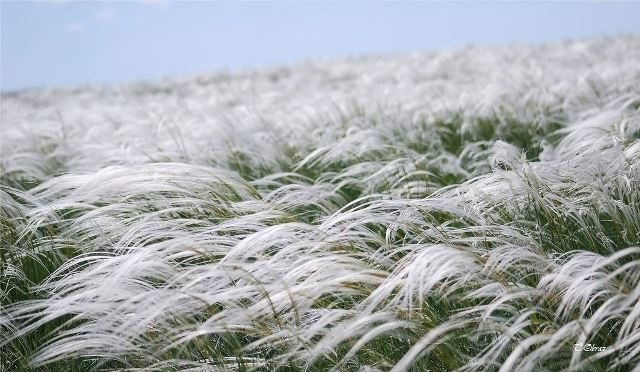

Feather grass - steppe plant
Plant features
An interesting phenomenon can be observed with the onset of darkness in the fields where feather grass grows. With a cold snap at night, dew falls on the leaves, and the lower part of the plant, which was previously rolled into a tube, begins to straighten. This pushes the feather grass to the ground. In this case, the panicle with grains simply lies on the ground, clinging to the protrusions with spiny bristles.
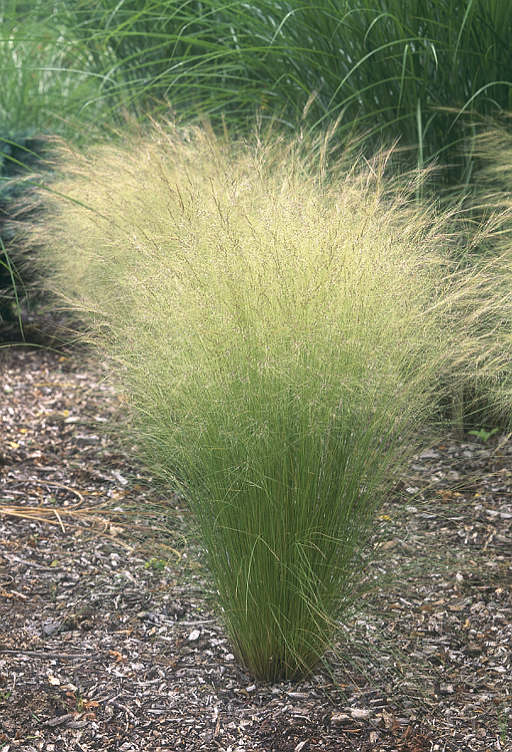

As the sun rises, the dew evaporates and the stem takes on its usual shape. The grass straightens out again, but some of the grain remains on the ground, germinating after another rain.
Feather grass recipes
Infusion and compress for goiter
Pour 3 tablespoons of feather grass into a thermos, pour boiling milk (3 glasses).
Let the night stand. In the morning, pour two glasses of infusion into another dish and drink by sip throughout the day. With the rest, moisten a cloth and apply it to the thyroid gland as a compress.
You need to be treated for at least two months.
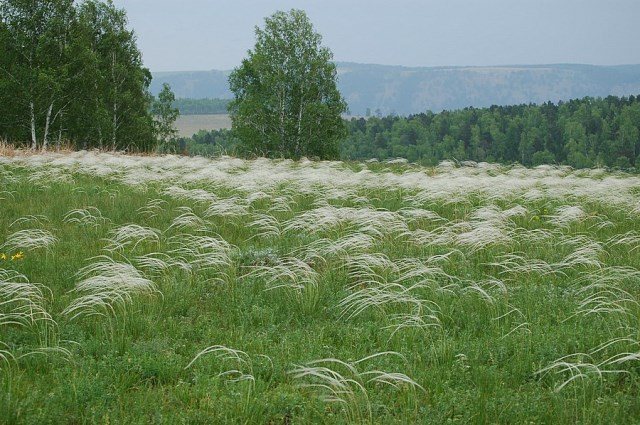

Summer feather grass in the field
Lotion for joint pain
Pour a handful of dry feather grass stalks with boiling water, then simmer over low heat for 5 minutes.
Let it brew to swell well. In a warm form, apply on sore joints, on top - cling film and a woolen scarf. Keep it on for 30 minutes.
Apply lotions until the pain disappears.
Siberian recipe for paralysis
Dig up a dead feather grass bush - it is the most useful one.
Take a handful of grass with a root (how much will fit in your hand), pour a liter of boiling water. When it cools down, drink instead of tea until you see improvement. It helps well against paralysis, even raises those who are repeatedly paralyzed.
When using feather grass for medicinal purposes, do not exceed the prescribed dose. Overdose is fraught with severe poisoning.
The feather grass plant is recognized by its characteristic dense bunches of long flexible awns of flowers above the peduncles. It is of great importance in various natural processes. To get an idea of this, you need to know where the feather grass grows?
In which natural area does feather grass grow?
Feather grass grows in the steppe and plays a very important role in her life. Next, consider what exactly the value of the steppe feather grass is:
- Effect of feather grass on soil fertility
... Steppe plants accumulate green mass, which determines the high fertility of the soil.Here, a huge role is played by "steppe sod", which is formed by dense tussocks of grasses, in particular, feather grass. The connection between feather grass and soil fertility has been known for a long time. - Restoration of virgin steppe lands
with the help of a feather grass. The seeds of the plant are carried over long distances by the wind. They are easily fixed in the soil. Therefore, feather grass is capable of sowing large areas of land in a short time. This is of great importance, since feather grass in this way displaces weeds, forms a dense turf and makes it possible for other species of steppe plants to gain a foothold. - Feather grass is a grazing plant
in the spring.
Thus, taking into account where the feather grass grows (in which zone), its natural advantages are determined.
Dangerous properties of feather grass
It should be borne in mind that, if handled carelessly, feather grass can cause a lot of trouble. Sharp plant seeds can seriously injure people or animals and are very difficult to remove. Therefore, the ingress of seeds into the body cavity may cause surgery.
In addition, it is by no means recommended to bring a bouquet of feather grass to the house. Its seeds can be bad for the respiratory system. This is especially true for those people who suffer from allergies or asthma.
Harm from a lot of feather grass
Farmers consider the grass a weed and try to get rid of a lot of it. This attitude is caused by the fact that feather grass, firstly, does not participate in the formation of the chernozem layer of the soil, and secondly, after the end of the growing season, fungi begin to actively develop in the roots of the plant, which secrete acidic enzymes into the soil. This makes it difficult for other grasses to grow, especially after dry summers.
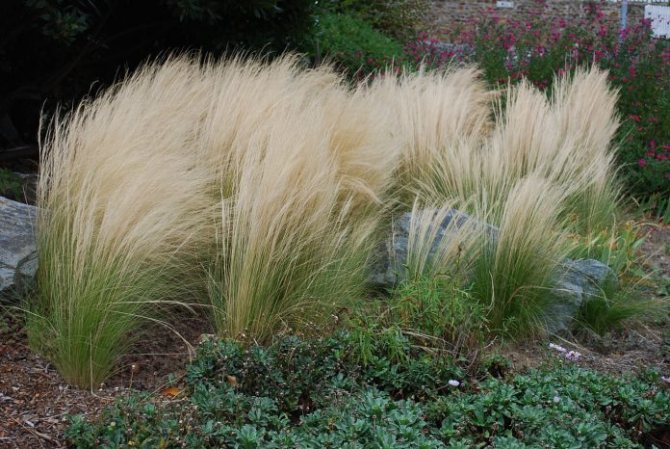

A large amount of feather grass in meadows leads to an ecological disaster, because other grasses often cannot withstand drought, which gives it a big advantage. Feather grass begins to actively spread, thereby clogging other plants. People have been struggling with this dominance for many years, planting more valuable perennial grasses, watering dry lands in meadows, making it possible to grow not only feather grass, but also other plant species.
It is often observed that the steppes hobble after the late fall of the grass. Such areas of the steppe are quickly overgrown with feather grass and annual weeds. Agricultural workers have to deal with weeds in all known ways.
Types [edit | edit code]
The genus comprises more than 300 species [3], including up to 100 dry-loving grasses growing between the tropics. Being dry lovers, feather grass settle on steppe meadows, on dry open hills, on rocks and stony placers.
The most famous species in Russia:
- Feather grass feathery ( Stipa pennata
L.), actually feather grass, the long spine of which is covered with soft hairs - Hairy feather grass, or Tyrsa ( Stipa capillata
L.), whose awn is not covered with hairs - The most beautiful feather grass ( Stipa pulcherrima
K.Koch) - Zalessky's feather grass ( Stipa zalesskii
Wilensky)
Often, species of the genus Chiy ( Achnatherum
).
Decorating personal plots
A photo of feather grass demonstrates its value as an ornamental culture, which is often used by landscape designers in the design of plots of land or alpine hills. It is possible to plant grass in April or May, some plant in the fall, they believe that in this way the seedlings will appear faster and will be more resistant to damage.
There are two planting methods - outdoors and seedlings grown indoors in pots. In the first case, a hole 3 cm deep is dug at an interval of 20 cm from one another. It is poured with water and seeds are placed, which are simply sprinkled with a layer of soil. You can lightly press your hands deeper on top of the powder.
When decorating the paths around the house, you can mulch the soil between the plantings of feather grass, namely, sprinkle the soil with expanded clay or small stones of crushed stone.
If you want to grow seedlings, make a hole in each pot, pour some water and put 3-4 grains of feather grass (pictured).
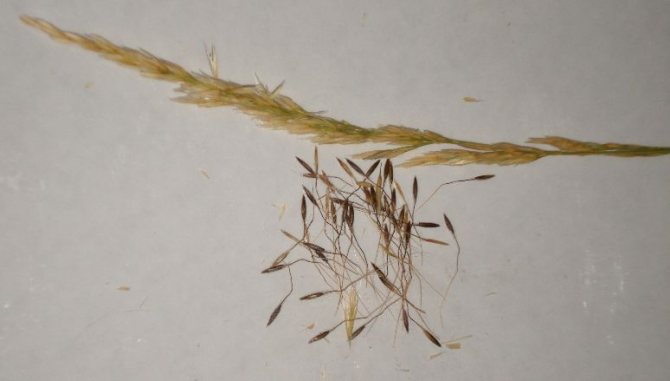

You do not need to press the seeds into the ground, just sprinkle the crops with 1 cm of soil from above. You can additionally moisten the soil with a spray bottle. Planting of seedlings begins in March, and after a month you can determine the plants in open ground. For such purposes, choose dry and not too fertile areas of land that will not be flooded after rain, since feather grass is incredibly sensitive to excess moisture. In Soviet times, watering meadows got rid of such grass, which exterminated huge quantities of it in nature.
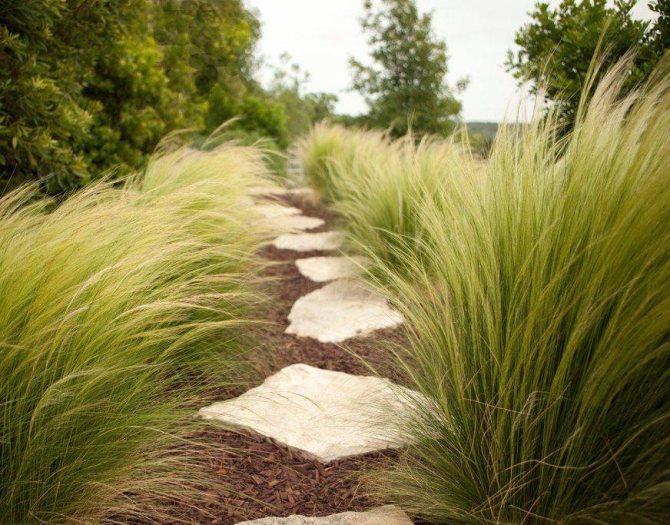

Taking care of crops is incredibly easy, because feather grass is very resistant to diseases and various pests. Even if neighboring plantings are infected with fungi, the feather grass will borrow the disease last. But it is not recommended to bring the grass to such a state, since acid gets into the soil from the fungi, which increases the acidity of the soil and harms other plants.
The plant looks incredibly beautiful on the site near the house, which is proved by the photo of feather grass above. And in dry summers, you do not have to constantly water the site in order to admire the lush vegetation around you.
Distribution and ecology [edit | edit code]
Feather grass and feather grass-hairy grow abundantly in Hungary and are found in dry places throughout Western Europe. Therefore, these plants cannot be considered black earth. Both of these grasses cover the still untouched virgin steppes of southern Russia and Siberia with bunches of their hard leaves. Less common species grow immediately: Lessing's Feather Grass ( Stipa lessingiana
Trin. & Rupr. ) and narrow-leaved feather grass (
Stipa tirsa
Steven), little different from Tyrsa (
Stipa capillata
). The only virgin areas where feather grass grows in Europe is the reserved steppe in Askania-Nova (Kherson region) and in the reserved Khomutov steppe (Donetsk region) in Ukraine.
In the Azov-Caspian countries, in the Gobi steppe, Stipa splendens Trin grows. , or Achnatherum splendens (Trin.) Nevski (downwood, or Chiy Kirghiz, or Chiy shiny), forming large and tall bundles of long and stiff leaves like a wire. They call this characteristic grass "hole".
An excerpt characterizing the Hairy Feather
The French colonel could hardly restrain a yawn, but he was courteous and, apparently, understood the full significance of Balashev. He led him past his soldiers by the chain and said that his desire to be presented to the emperor would probably be immediately fulfilled, since the imperial apartment, as far as he knew, was not far away. They drove past the village of Rykonta, past the French hussar hitching posts, sentries and soldiers saluting their colonel and examining the Russian uniform with curiosity, and drove to the other side of the village. According to the colonel, the division chief was two kilometers away, who would receive Balashev and escort him to his destination. The sun had already risen and shone merrily on the bright greenery. They had just left the tavern on the mountain, when a group of horsemen appeared to meet them from under the mountain, in front of which, on a black horse with a harness shining in the sun, was riding a tall man in a hat with feathers and black hair curled up to his shoulders, in a long legs protruding forward, like the French ride. This man rode at a gallop towards Balashev, glittering and fluttering in the bright June sun with his feathers, stones and gold braids. Balashev was already two horses away from a horseman in bracelets, feathers, necklaces and gold galloping towards him with a solemn theatrical face, when Yulner, a French colonel, respectfully whispered: "Le roi de Naples." [King of Naples.] Indeed, it was Murat, now called the King of Naples.Although it was completely incomprehensible why he was the king of Naples, he was called that, and he himself was convinced of this and therefore had a more solemn and important appearance than before. He was so sure that he was really a Neapolitan king that when, on the eve of his departure from Naples, during his walk with his wife through the streets of Naples, several Italians shouted to him: “Viva il re!” [Long live the king! (Italian)] he turned to his wife with a sad smile and said: “Les malheureux, ils ne savent pas que je les quitte demain! [Unhappy, they do not know that I am leaving them tomorrow!] But despite the fact that he firmly believed that he was the King of Naples, and that he regretted the sorrow of his subjects, who were leaving them, recently, after he was ordered to re-enter the service, and especially after a meeting with Napoleon in Danzig, when the august brother-in-law said to him: “Je vous ai fait Roi pour regner a maniere, mais pas a la votre” [I made you king so that reign not in his own way, but in my opinion.] - he cheerfully set to work familiar to him and, like an eroded, but not fattened, fit for service horse, sensing himself in a harness, played in the shafts and, having discharged himself as colorful and expensive as possible, cheerful and contentedly, he rode, not knowing where and why, along the roads of Poland.
Feather grass as a decoration of the landscape
Feather grass fascinates at first sight. This grass, unpretentious in care, has won the hearts of gardeners, decorating gardens and flower beds. Naturally, not every variety of feather grass is equally interesting for landscape design. In addition, in our climate, only certain varieties of this plant feel good. Swaying like waves, feather grass spikelets are surrendered to the power of the wind, which creates a bewitching sight. And the thicker this grass is planted, the more spectacular its appearance.
You can create wonderful natural compositions with the help of feather grass in gardens. The right combination of feather grass with some other plants found in meadows will make your flower bed irresistible and as close as possible to the wild landscape. To this end, you should pay attention to: fescue, foxtail, miscanthus and many other interesting grasses.
For example, the proximity of feather grass with scabios, a bright and juicy shade, will help to achieve a harmonious look in the garden. With poppies, heather, sage, hyssop, chamomile, echinacea, ornamental onions or garlic. The role of feather grass in these compositions can be either leading or secondary.
Feather grass can also perfectly fit into the vegetation of ponds, being planted next to heuchera, iris, sedge or reeds. Ideally, land it on the side of the path to the pond, and not at the reservoir itself.
It's not a bad idea to set up feather grass along the fence. It will perfectly fit into the design of the garden, outlining its boundaries with an airy mood. And how beautifully it is combined with a wicker fence made of twigs or by the pillars of a pergola.
And even though the feather grass is a steppe plant, it can still be easily planted next to ornamental plants. For example, it will become an excellent neighbor to the Thunberg barberry or turf. Dwarf breeds of conifers also welcome feather grass into their surroundings, and therefore they can even decorate an alpine hill.
In addition, the fantasy of landscape designers does not end there. Every day they invent the latest combinations of feather grass with other plants, delighting their customers.
Feathery compositions in modern decor
Almost all varieties of this unusual plant are especially popular with specialists in landscape creations, who create their works on the principles of the unique and strict beauty of wild nature. The inflorescences of the cereal, like all representatives of its family, are nondescript, resemble the filaments of an electric lamp, but the extravagant look of the leaves and stem awakens artistic imagination. The feathery bush is capable, spreading its delicate feathers, beautifully cast in the wind with silvery silk.
Feather grass is widely used in modern decor thanks to its long silky awns that create a magical picture from the slightest breath of wind.
Cut inconspicuous inflorescences are graceful, bringing an unrivaled simplicity of harmony to lively and dry flower arrangements.
An unpretentious plant is specially propagated using the following:
- for decorating backyard territories,
- as a component in the landscape design of the fashionable "prairie" style,
- when arranging alpine slides,
- in the creation of bouquet compositions, especially from dried flowers and leaves.
This cereal is planted in open areas with well-drained soil in clumps, creating a natural garden, in rose gardens or on alpine hills, in the vicinity and in combination with other plants:
- drought-resistant, with which they live in the steppe neighborhood or in meadows (fescue, foxtail, poppies, cornflowers, chamomiles, echinacea, heather);
- with an unusual winning combination of compositions with plants with small flowers, or roses, ornamental bushes, conifers.
Growing methods
Feather grass is propagated traditionally in two ways:
- when a certain density and size is reached, the bush is divided into several parts (no more than 3-4 bushes are obtained);
- sowing seeds that do not require special care when growing.
During reproduction, a number of simple conditions must be met:
- It is necessary to find the right place for feather grass to "live" away from closely located groundwater and to have a lot of sun there.
- Choose a species that grows without problems in the climate of the middle zone.
Content
- 1. Description 1.1. Popular varieties and varieties
Feather grass is a member of the Poaceae family. The numerous genus includes 329 varieties of cosmopolitan plants. Most of the species grows in steppe and semi-desert areas.
Some representatives of the genus, for example, the related feather grass (Stipa consanguinea), are rare, included in the Red Book of Russia and regional lists of endangered plants.
The Latin name for the Wiggler, Stipa, comes from the ancient Greek noun for tow. It is given for the hairy-pinnate processes on its spikelet or flower scales, the so-called. awn.
Signs associated with feather grass
Feather grass, covered with secrets no less than other plants. There is a belief that feather grass is supposedly a widow's grass, and therefore it cannot be kept at home. Because if one of the women disobeys and brings this herb into the house for storage, she will become a widow. And this sign arose from ancient times, when, during the flowering period of feather grass, nomads attacked villages, killing men. A strange coincidence, but it was this that gave rise to this belief. And the spikelets of feather grass resembled the gray hair of widowed mothers and wives.
Despite the first sign, there was another one. She said that feather grass is not an ordinary plant. It belongs to the spirits of the steppe and is able to protect a person from all kinds of troubles. To do this, it was necessary to hide a bunch of feather grass under your clothes.
According to these beliefs, the conclusion is obvious - it is still not worth keeping feather grass at home, but in the garden - grow it with peace of mind. Feather grass will not only decorate your landscape design, but also give the feeling of merging with the wild.
There are more than 300 species in the world, in our country - more than 80. These plants are widespread in both hemispheres. In this article, we will take a closer look at one representative of this genus, namely feather grass.
This plant grows in Europe, the Caucasus, and Kazakhstan. In our country, feather grass was originally distributed only on the territory of the steppes or areas with rocky slopes.However, about 20 years ago, its seeds were introduced to other regions of Russia, and now this plant can be found almost everywhere, mainly on roadsides, in glades and fields.
Feather grass is a perennial grass that grows up to 1 m in height. Its characteristic feature is long narrow rough leaves and fluffy nets-panicles extending from the grains that are in the ear. When the plant is still young and the seeds are not ripe in it, the skeleton hairs are very soft. If you touch them, you immediately get the impression that you are stroking some fluffy animal. But everything changes after the grains ripen at the feather grass. The edge of the spike becomes stiff and can be injured. These hairs are needed in order for the heavy seeds to spread through the air - so the plant can sow a large area.
Growing for decorative purposes
Feather grass is a beautiful plant. When the wind blows, it sways and falls to the ground, forming silvery gray waves. One gets the impression that the ground is covered with a silk veil. Although this is very conditional - for many, such a picture evokes melancholy. Be that as it may, feather grass is a rare guest in gardens and parks. It's all about the hard hairs - they are very spiny, and therefore gardeners do not like to grow this plant. However, feather grass is still occasionally planted as a supplement to other flowers and shrubs, in order to make some kind of garden composition.
In other cases, it is classified as a weed, since it causes significant harm to farms. It is not suitable for livestock, and if prepared along with hay, the animal can suffer - the coarse hairs can damage its mouth or esophagus. Livestock, on the other hand, eats young plants very well.
Feathery feather grass is brought in. This is due to the fact that its traditional habitats - the steppes - are increasingly plowed up for useful crops or given for grazing. And although in small quantities this type of plant is quite common, real feather grass steppes are already considered a valuable relic.
Application
Feather grass is sometimes used in folk medicine. The chemical composition of this plant has not been studied, therefore it is not known which substances have an effect on the human body. However, herbalists and healers have been using feather grass decoction in milk for many years to treat thyroid disorders and leaf poultices for paralysis. However, there is no evidence that such alternative methods will be effective or even safe.
Feather grass is a fairly well-known plant that belongs to the cereal family. It is a grass with a height of 30 cm to a meter, with a short rhizome (not creeping) and a rather dense bush. The feather grass plant is perennial and propagated by seeds. In nature, there are about 300 types of feather grass
... About 80 of them grow in our country. Under natural conditions, the steppes often form dense sod, but due to active agricultural activity it is now rare.
Feather grass leaves are thin and tough, resembling wire, sometimes even twisted into a tube. Stems are erect and thin too. Feather grass
releases in the form of a dense paniculate inflorescence-spikelet at the end of May. It has a very original structure, in which the grain is located in the lower floral scales, which have a callus (pointed apex) and an awn. The bristles on the spikelet are located in the opposite direction of the spine, and the spine itself is twisted into a spiral.
Ripe seeds are spread by the wind. But there is another way, due to the peculiar structure of the spikelet. Under the influence of dew or rain, feather grass stalks take root to the ground, the spiral awn straightens slightly from moisture, and, like a corkscrew, is screwed into the ground. Scales do not give her to go back out. Then the spikelet dries up and breaks off, and the seeds remain in the soil.
Impact on agriculture
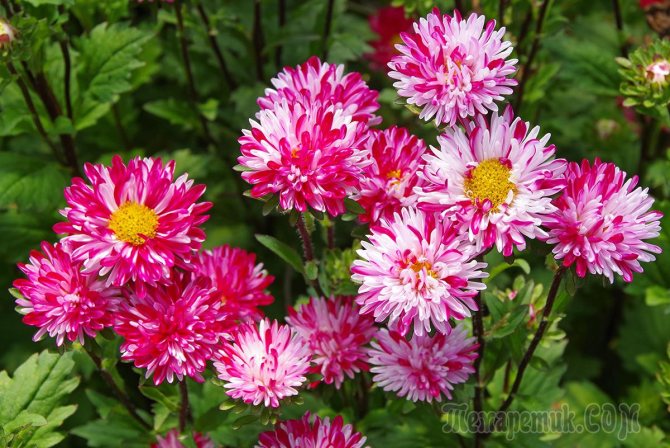

Feather grass does not belong to fodder crops; it is considered a weed by agronomists. It has a negative effect on fertile species of flora, since after the end of the growing season, it contributes to the development of fungal diseases, continuing to grow - it releases acid enzymes into the ground. Weak roots of Stipa negatively affect the ecosystem of agricultural land because they are not able to form chernozem. The plant acts as a parasite, taking some of the nutrients from the soil where it grows.
The “feather grass” disease caused by sharp spikelets of feather grass on the skin of livestock cannot be attributed to its advantages. Therefore, it is recommended to mow down feather grass before flowering.
Important! Blooming grass can cause an allergic reaction in a person or the development of asthma.
Popular talks
- Report by Ilya Efimovich Repin Grade 5 message
Once a cousin gave little Ilya Repin watercolors. In front of the boy's eyes, he immediately drew a cut watermelon, and the future famous artist of Russia, seeing how a drawing was born, - Report Operating system linux message
The creator of the operating system (OS) is the Finnish programmer Linus Torvalds. In 1991, while a student at the University of Helsinki, Linus became interested in studying OS. The Linux prototype was the Minix license, - Report Methods of Geographic Research Grade 5 Post
As in other sciences, there are special research methods in geography. Let's consider some of them. In ancient times, people got their own food, created dwellings. In the caves they painted their cave paintings,
Industrial and agricultural applications
Hairy feather grass is prized as pasture feed for livestock. Its succulent stems, mown at the beginning of summer, are fed to horses and sheep. Cattle do not eat it.
By the time flowering ends, it becomes impossible to graze livestock on the steppe meadows. Sharp as needles, feather grass spines pierce the skin and mucous membrane of the mouth of animals, causing excruciating pain and causing swelling and inflammation, and often suppuration of puncture sites. This misfortune has its own name - “feather grass disease”.
Another type of feather grass - esparto - is successfully used in industry. Artificial silk and paper are made from it.
Care
It is necessary to sow feather grass in the ground or by seedling at a distance of 20 cm from each other. All care of crops is reduced only to clearing the land of weeds. If there is such a desire, then you can mulch the soil. This plant does not need to be specially watered or fed, as it tolerates drought persistently.
In order for feather grass to grow with pleasure, it is important to plant it in sunny places, away from water bodies. This plant does not welcome excessive moisture. He also has a dislike for acidic soils. Therefore, if a high acidity of the soil is noticed, lime must be introduced into it.
Divide too thick bushes in half. The best time for this event is spring. After such a procedure, the plant will take on a more spectacular appearance, and besides, as we already know, this is a great way to propagate feather grass.
Diseases and pests
On waterlogged soils without drainage, Feather grass often perishes from root rot. Sometimes its shoots are affected by various fungal and bacterial infections. Fungicides are saved from them: Abiga-Peak, Fundazol, Topaz.
Feather grass is especially vulnerable to diseases and pests when growing on slightly acidic soils. Liming the ground before planting is considered an effective measure of plant protection.
Like other Myatlikovs, Kovlyu can be damaged by mealybugs, spider mites, aphids, especially gray swine-cereal. Ticks and insects will be expelled by Actellik and Aktara insectoacaricides.
Interesting Facts
Feather grass is called Stipa in Latin. When translated from Greek, the word "tow" is obtained. This is understandable, since most of the species (including hairy feather grass) have dense pubescence of stems and leaves.
Some features and interesting facts about feather grass:
- Feather grass has a daily activity. At night, when the plant is covered with abundant dew, feather grass, curling up, is pressed to the ground. With the morning sunrise, the dried plant straightens out.
- The seeds, which have a special structure, dig into the body of the animal, causing the appearance of purulent wounds and boils. At the same time, it is noted that the quality of meat also deteriorates.
- This grain is the strongest allergen. In this regard, this fact should be taken into account when making bouquets with it. For people with allergies or asthma, such bouquets are a big problem.
Care
In the photo, the thinnest feather grass "Pony Tails"
When sowing feather grass seeds into the ground or through seedlings, the distances between the plants are made about 20 cm
... The main care is to periodically weed out. If desired, you can mulch the soil.
Frequent watering or feeding is not required, since feather grass is steppe plant and accustomed to drought
... The main thing is to choose a good sunny place for it, where it will not be threatened by groundwater close to the surface, since
he does not like excessive moisture
... Also, feather grass does not really like acidic soils, so if the acidity index is high, lime must be added.
If the feather grass has grown thick enough, it can be divided in the spring. This is not only a method of propagation, but also beneficial for the plant itself, so that it blooms more effectively.
What is feather grass
From the many common varieties of feather grass, landscape designers have selected a few of the most attractive species.
- Feathery Often decorates gardens and flower beds. Fully adapted to the climatic characteristics of the middle zone, therefore it hibernates without shelter. Plant height with smooth stems and elongated panicles is up to 90 cm. Flowering occurs in May-June.
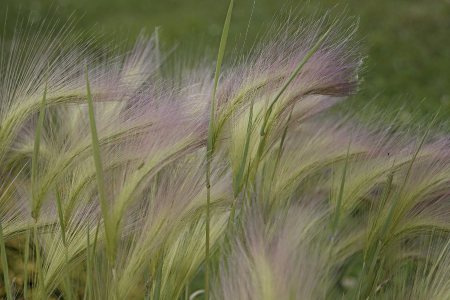

Pinnate - Beautiful This feather grass has many similarities with the feathery species, which is noticeable in the photo of the plant. Only his panicles are much denser and inclined to the ground. The smooth bending of the panicles gives the feather grass a special decorative effect.
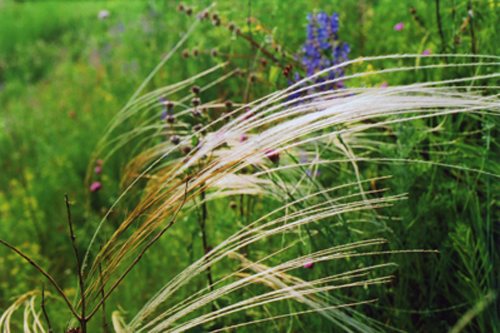

The most beautiful - Feather grass "Fluffy cloud" A small bush does not grow higher than 50 cm. Erect spikelets merge into a lush mass, confirming its name.
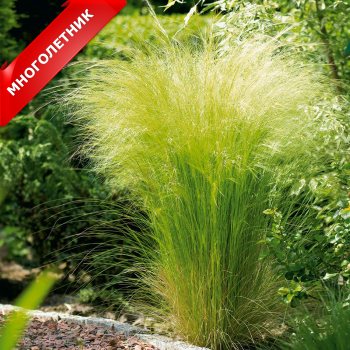

Fluffy cloud - The thinnest It is of Mexican origin and therefore thermophilic. Although high temperatures from + 25 ° C are also contraindicated for him. The annual culture grows no higher than 80 cm. The thinnest feather grass has hard leaves and white-silvery panicles.


The thinnest - Zalessky's feather grass Belongs to the feathery feather grass species. Grows on poor soils and salt licks. The leaves are hairy with pimples. The structure of the panicle is loose, with slight pubescence.
- Feather grass "Fireworks" Grows like a perennial in warm climates. The height of the bush is up to 80 cm. It has the ability to change the color of the leaves from dark green in spring to golden pink in the summer months. With the arrival of autumn, it turns red or brown.
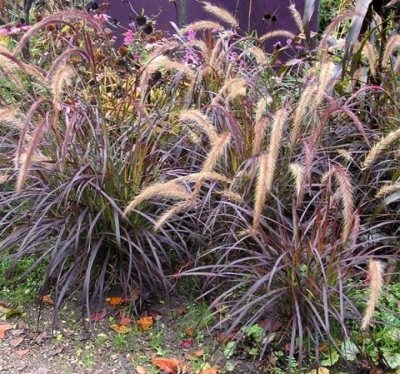

Fireworks - Lessing's feather grass The height of the bush is up to 60 cm. The outer side of the leaves is rough. Dry leaves curl. The panicles are purple.
- Feather grass "Volosatik" It grows up to 60 cm. The plant differs from other feather grass by thin and long awns, comparable to horse hair. The ear is colored silvery-green.
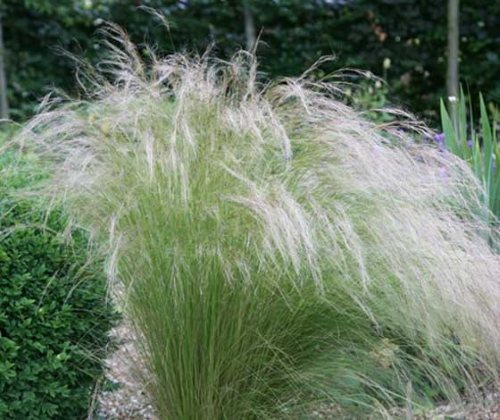

Hairy

